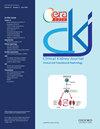慢性肾脏病患者和普通人群中的椎体骨折:呼吁诊断和行动
IF 3.9
2区 医学
Q1 UROLOGY & NEPHROLOGY
引用次数: 0
摘要
椎体骨折(VFs)是普通人群中最常见的骨质疏松性骨折,与高死亡率、生活质量下降和后续骨折的高风险有关,尤其是近期、多发性或严重骨折。目前,VF 的诊断和分类决定了骨折风险和最合适的抗骨质疏松治疗。然而,VF 明显诊断不足,尤其是在慢性肾脏病(CKD)患者中,而且直到最近,CKD 相关骨质疏松症一直被忽视。骨质疏松症与较高的发病率和死亡率相关,其发病率和发生率因肾功能障碍的等级(CKD G1-G5)和/或肾替代治疗的类型(透析或移植)而异。除了传统的风险因素(如高龄、女性、骨矿物质密度(BMD)降低、糖尿病和使用类固醇)外,其他各种因素也与 CKD VFs 风险增加有关,包括 CKD 等级、血液透析年份、肾移植后的时间、甲状旁腺激素和磷酸盐水平过低或过高、和/或维生素 D 和 K1 缺乏。重要的是,一些临床学会最近根据骨折风险分类(包括是否存在室间隔缺损)修改了其算法,并确定了最适合普通人群的抗骨质疏松治疗方法。然而,尽管在 2017 年《慢性肾脏病-矿物质和骨质紊乱(CKD-MBD)KDIGO 指南》发布后,有关 BMD 预后价值的范式发生了重要转变,但目前还没有针对慢性肾脏病患者的具体指南。建议对诊断、治疗和研究采取积极主动的态度,以避免治疗虚无主义。本文章由计算机程序翻译,如有差异,请以英文原文为准。
Vertebral fractures in patients with CKD and the general population: a call for diagnosis and action
Vertebral fractures (VFs) are the most common osteoporotic fractures in the general population, and they have been associated with high mortality, decreased quality of life and high risk of subsequent fractures, especially when recent, multiple or severe. Currently, VF diagnosis and classification determine fracture risk and the most appropriate anti-osteoporotic treatment. However, VFs are clearly underdiagnosed, especially in patients with chronic kidney disease (CKD), and CKD-associated osteoporosis has been disregarded until recently. VFs are associated with higher morbidity and mortality, and their prevalence and incidence differ depending on the grade of renal dysfunction (CKD G1–G5) and/or the type of renal replacement therapy (dialysis or transplantation). In addition to classical risk factors [such as higher age, female sex, reduced bone mineral density (BMD), diabetes and steroid use], various other factors have been associated with an increased risk of VFs in CKD, including CKD grade, haemodialysis vintage, time since renal transplantation, low or high intact parathyroid hormone and phosphate levels, and/or vitamin D and K1 deficiencies. Importantly, several clinical societies have recently modified their algorithms according to the fracture risk classification (including the presence of VFs) and determined the most appropriate anti-osteoporotic treatment for the general population. However, there are no specific guidelines addressing this topic in patients with CKD despite an important paradigm shift regarding the prognostic value of BMD in 2017 after the publication of the CKD-Mineral and Bone Disorder (CKD-MBD) KDIGO guidelines. A proactive attitude towards diagnosis, treatment and research is proposed to avoid therapeutic nihilism.
求助全文
通过发布文献求助,成功后即可免费获取论文全文。
去求助
来源期刊

Clinical Kidney Journal
Medicine-Transplantation
CiteScore
6.70
自引率
10.90%
发文量
242
审稿时长
8 weeks
期刊介绍:
About the Journal
Clinical Kidney Journal: Clinical and Translational Nephrology (ckj), an official journal of the ERA-EDTA (European Renal Association-European Dialysis and Transplant Association), is a fully open access, online only journal publishing bimonthly. The journal is an essential educational and training resource integrating clinical, translational and educational research into clinical practice. ckj aims to contribute to a translational research culture among nephrologists and kidney pathologists that helps close the gap between basic researchers and practicing clinicians and promote sorely needed innovation in the Nephrology field. All research articles in this journal have undergone peer review.
 求助内容:
求助内容: 应助结果提醒方式:
应助结果提醒方式:


